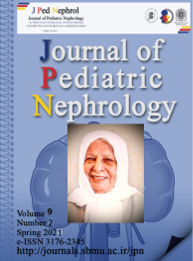A Rare Case of Renal Salt Wasting Associated with Metabolic Acidosis and Hyperkalemia Hyperkalemia
Journal of Pediatric Nephrology,
Vol. 9 No. 2 (2021),
14 April 2021
,
Page 1-2
https://doi.org/10.22037/jpn.v8i2.33690
Abstract
In the evaluation of patients presenting with chronic hyperkalemia hyponatremia and normal anion gap acidosis, pseudohypoaldosteronism types I and II are within the spectrum of differential diagnosis. Recognition of these patients is important to prevent inappropriate mineralocorticoid therapy. Using clinical scenarios we aim to illustrate clinical mimics and dissimilarities to differentiate theses disorders.
Keywords:
- Hyperkalemia
- Hyponatremia
- Metabolic Acidosis
- Pseduohypoaldosteronism
How to Cite
1.
Assadi F, Emami E. A Rare Case of Renal Salt Wasting Associated with Metabolic Acidosis and Hyperkalemia: Hyperkalemia. J Ped Nephrol [Internet]. 2021 Mar. 31 [cited 2024 Apr. 18];9(2):1-2. Available from: https://journals.sbmu.ac.ir/jpn/article/view/33690
References
References
1. Assadi F. Clinical disorders associated with altered potassium metabolism. In: Elzouki AY, Harif HA, Nazer H, Stepleton FB, Oh W, Whitley RJ (eds). Textbook of clinical pediatrics, 2nd edn, Springer, New York, 2011, Vol 4, Section 284, p 2663-2670.
2. Casas-Alba D, Vila Cots J, Monfort Carretero L, Martorell Sampol L, Zennaro MC, Jeunemaitre X, et al. Pseudohypoadlosteronism types I and II: little more than a name in common. J Pediat Endocrinol Metab. 2017;30:597-601.
3. Scheinman SJ, Guay-Woodford LM, Thakker RV, et al. Genetic disorders of renal electrolyte transport. N Engl J Med. 1999;34):1177-1187.
4. Geller DS, Zhang J, Zennaro M-C, Vallo-Boado A, Rodriguez-Soriano J, Furu L, et al. Autosomal dominant pseudohypoaldosteronism type I; mechanisms, evidence for neonatal lethargy, and phenotypic expression in adults. J Am Soc Nephrol.2006;17:1429-1436.
5. Chang SS, Grunder A, Hanukog;u A. et al. Mutations in subunits of the epithelial sodium channel cause salt wasting with hyperkalemic acidosis, psseudohypoaldosteronism type I. Nature Genetics.1996;12:248-253.
6. Martin JM, Calduch L, Monteagudo C, Alonso V, Garcia L, Jorda E, et al. Clinico-pathological analysis of the cutaneous lesions of a patient with Type 1 pseudohypoaldosteronism. J Eur Acad Dermatol Venereol. 2005;19:377-379.
7. Batlle D, Arruda J. Hyperkalemic forms of renal tubularacidosis: Clinical and pathological aspects. Adv Chronic Kidney Dis.2018;25:321-333.
8. Kalburova F. Robeva R, Belovezhdov N. Gordon’s syndrome hypertension and hyperkalemia associated with normal glomerular filtration rate. Nephron.1992;60:124
9. Luft FC. Mendelian forms of human hypertension and mechanisms of disease. Clin Med Res.2003;1:291-300.
1. Assadi F. Clinical disorders associated with altered potassium metabolism. In: Elzouki AY, Harif HA, Nazer H, Stepleton FB, Oh W, Whitley RJ (eds). Textbook of clinical pediatrics, 2nd edn, Springer, New York, 2011, Vol 4, Section 284, p 2663-2670.
2. Casas-Alba D, Vila Cots J, Monfort Carretero L, Martorell Sampol L, Zennaro MC, Jeunemaitre X, et al. Pseudohypoadlosteronism types I and II: little more than a name in common. J Pediat Endocrinol Metab. 2017;30:597-601.
3. Scheinman SJ, Guay-Woodford LM, Thakker RV, et al. Genetic disorders of renal electrolyte transport. N Engl J Med. 1999;34):1177-1187.
4. Geller DS, Zhang J, Zennaro M-C, Vallo-Boado A, Rodriguez-Soriano J, Furu L, et al. Autosomal dominant pseudohypoaldosteronism type I; mechanisms, evidence for neonatal lethargy, and phenotypic expression in adults. J Am Soc Nephrol.2006;17:1429-1436.
5. Chang SS, Grunder A, Hanukog;u A. et al. Mutations in subunits of the epithelial sodium channel cause salt wasting with hyperkalemic acidosis, psseudohypoaldosteronism type I. Nature Genetics.1996;12:248-253.
6. Martin JM, Calduch L, Monteagudo C, Alonso V, Garcia L, Jorda E, et al. Clinico-pathological analysis of the cutaneous lesions of a patient with Type 1 pseudohypoaldosteronism. J Eur Acad Dermatol Venereol. 2005;19:377-379.
7. Batlle D, Arruda J. Hyperkalemic forms of renal tubularacidosis: Clinical and pathological aspects. Adv Chronic Kidney Dis.2018;25:321-333.
8. Kalburova F. Robeva R, Belovezhdov N. Gordon’s syndrome hypertension and hyperkalemia associated with normal glomerular filtration rate. Nephron.1992;60:124
9. Luft FC. Mendelian forms of human hypertension and mechanisms of disease. Clin Med Res.2003;1:291-300.
- Abstract Viewed: 138 times
- PDF Downloaded: 180 times

